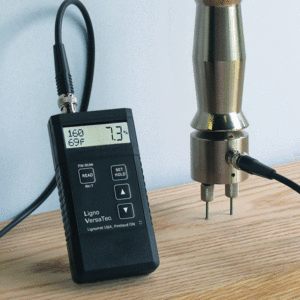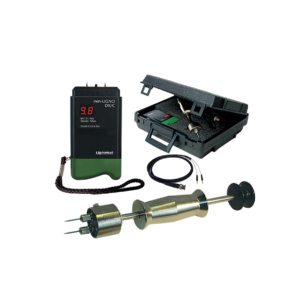High or low moisture in floor planks are major factors that can ruin a wood floor. Even the most beautiful, perfectly installed floor will end up with cupping or bowing if the moisture content of the floor planks was not right at the time of installation or if conditions changed afterward.
Depending on the wood species, smaller or larger dimensional changes occur when the moisture content changes. With hundreds of boards laying side by side, the defects become very obvious. In addition, when light shines across a floor, even small deformations are easily visible. Therefore, the first step toward a successful floor installation is to ensure that the wood is at the correct moisture content. The versatility of pin meters makes them a good choice for the flooring professional.
Here is how they work: They measure the electrical resistance between two metal pins. Moisture is measured in the small area between the metal pins. Pins can be mounted directly onto the meter or an external slide hammer electrode can be connected to the meter via a cable. The electrode typically comes with longer insulated pins allowing deeper measurements.

Pin meter with slide hammer electrode and insulated pins, V2-M.
Pin meters are versatile. They are used to measure the moisture in floor planks, when the floor is sold, delivered, acclimated, installed, and afterward. They can measure moisture in subfloors as well, to make sure the manufacturer’s guidelines for moisture ranges are followed.
To investigate floor problems, an inspector can use a meter with a slide hammer. This is one application where no other tool but a slide-hammer electrode with insulated pins can produce relevant information.
As the inspector hammers the pins deeper into the floor, he or she will see if the moisture values increase, decrease, or stay the same. They can continue to hammer the pins deeper to also measure the moisture in the subfloor without removing any floor planks, gaining valuable information, which will help in the diagnosis of the moisture problem. The only drawback is that this will leave two pinholes.

Meter with pins and slide hammer attachment (D2-M) used to check a problem gymnasium floor.
The advantage of pin meters is that they measure small areas and thus can pin-point a moisture gradient or differentiate between surface and core moisture. The other option is using a pinless meter, which measures a larger area, but always indicates only one moisture value depending on which depth the meter is testing at, even if the moisture underneath the measuring plate varies. The advantage is that it leaves no pin holes.
To obtain accurate moisture measurements, all pin moisture meters – and indeed all moisture meters – have to be corrected for the wood species. The correction settings for different wood species have to be determined through an oven test; they are not based on the specific gravity (which applies to pinless meters only).
A correction is necessary because different wood species vary in chemical composition, density, heartwood and sapwood, and structural differences due to growth rings. If you would measure samples of different wood species, all acclimated to 9 percent with a moisture meter that is not corrected for wood species, you might obtain values between 7 percent and 11.5 percent without accounting for the standard deviation. For accurate measurements, the meter has to be set for the correct wood species. Each meter manufacturer provides corrections for their moisture meters. The correction settings often are preprogrammed in the meters.
There is one more factor influencing the moisture value indicated by a pin meter: the wood temperature (not the air temperature surrounding the wood). If the wood is hotter or colder, the meter should be set for the wood temperature, or a correction table should be used.

The ideal floor package D2-M with slide hammer electrode with insulated pins.
It is crucial to record moisture measurements to show a job has been done well. These records also can be referred to in the future in case problems arise. The records should include the meter’s name, the date, the area where the measurements were taken, the wood species correction setting, the temperature setting, the measuring depth, and, of course, the indicated moisture value. A photo is always helpful.
Moisture content is an important issue, because throughout its lifespan, wood will stay a hygroscopic material. Its moisture content can change. The only way to measure moisture accurately is by using a moisture meter.
→ Click to read Pin Moisture Meters for Wood Floors from Hardwood Floors Magazine by Grete Heimerdinger, co-owner and vice president of Lignomat.
→ Click for more info on Lignomat Pin Moiture Meters.

